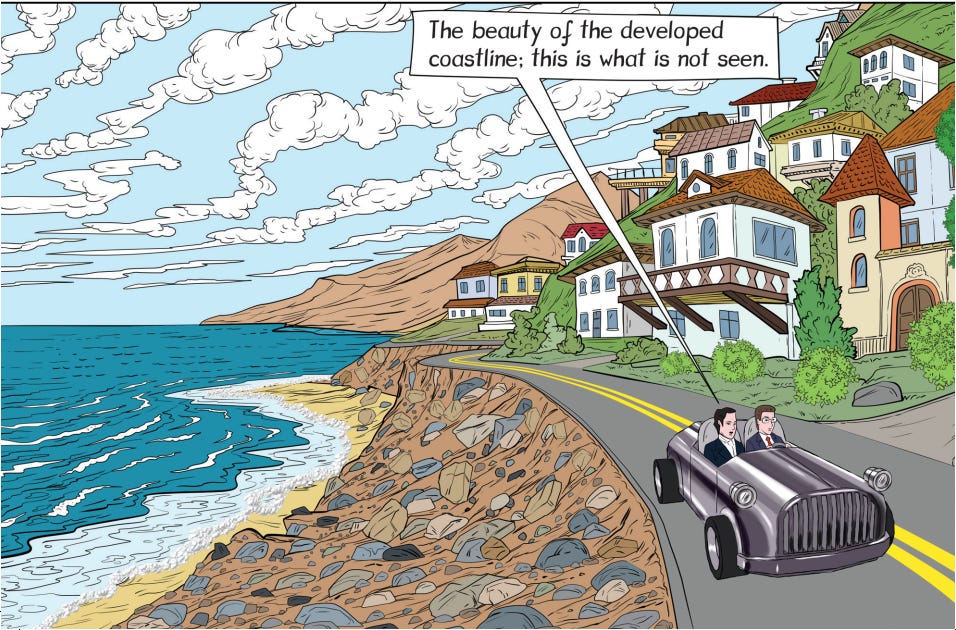All of My Guest Posts for Cato at Liberty
Plus a bonus 2011 Cato Unbound essay on fertility and liberty.
I recently guest blogged for Cato at Liberty. The Cato Institute is of course the kind publisher of my Build, Baby, Build. Here’s everything I wrote for them.
Bastiat’s Buildings: Why I Wrote a Graphic Novel about Housing Regulation. Highlight:
The epiphany that convinced me to write Build, Baby, Build: Instead of trying to argue people out of their aesthetic pessimism, I should use the graphic novel format to fight aesthetics with aesthetics — to show readers the beautiful unseen world that government forbids. And that’s why the fifth chapter of the book resurrects the great Bastiat as a co‐narrator.
Housing Deregulation as Poverty Policy. Highlight:
Anything that reduces poverty counts as poverty policy! Indeed, if you want to help the poor, Effective Altruism 101 urges us to start by adopting all of the policies that cost less than nothing. Shackling construction is a prime example of such a policy. After all, housing regulation hurts the poor by burning taxpayer resources to impede wealth creation. Harm fueled by waste and more waste.
Housing deregulation isn’t just one sort of poverty policy. It is the best sort of poverty policy.
The History of the Future: Build, Baby, Build on Historic Preservation. Highlight:
But even if you take the positive externalities more seriously than I do, we’re not choosing between positive externalities and nothing. We’re choosing between the positive externalities of the buildings we have, and positive externalities of the buildings we could have instead. People in the past were right to believe that the future could easily outshine the past. Why shouldn’t we believe the same?
Building for Babies: Build, Baby, Build and Fertility. Highlight:
Density suppresses fertility” and “High housing prices suppress fertility” are very hard to distinguish empirically. After all, why do urbanites live in such small places? In large part, because large residences in urban areas are extremely expensive. Imagine, though, that a 5000 square foot apartment in Manhattan rented for $1000 a month. Should we really think that New Yorkers wouldn’t spring for the extra elbow room? And once they have this extra elbow room, will the fertility effect really vanish because they’re too high off the ground?
P.S. When my Selfish Reasons to Have More Kids came out, Cato Unbound ran a symposium. My target essay was called “Population, Fertility and Liberty.” Highlight:
From the sixties to the eighties, the problems on people’s minds were overpopulation and the “population explosion.” The proposed solutions were usually government programs ranging from mild nudges (like free condoms and sex education) to horrific coercion (like India’s involuntary sterilizations and China’s one-child policy and forced abortions).[1]
During this period, libertarians were predictably quick to oppose government action and defend individuals’ right to have as many children as they wished.[2] But they also developed a more intellectually creative response. Under the seminal influence of Julian Simon, libertarians embraced the view that high and growing population is good. The title of Simon’s most famous book became a leading libertarian slogan: People are the ultimate resource.[3]
Over the last two decades, the perceived population problem has radically changed. Fertility has sharply fallen all over the world. It fell in less-developed nations, deflating long-standing Malthusian fears. But it fell in developed nations as well. Except for the United States and Israel, every modern economy now has fertility below the replacement rate.[4] Without high levels of immigration, most will see their populations fall in coming decades.[5] In Germany, Japan, and Russia, with total fertility rates around 1.3, population decline has already arrived.
Libertarians could celebrate these changes as proof that the problem of overpopulation solves itself whether or not governments do anything about it. But if Julian Simon and the intellectual tradition he inspired were right, libertarians should be experiencing severe cognitive dissonance. People with zero appreciation of Simon now worry about low birth rates and falling populations. How can those of us who long maintained that “people are the ultimate resource” fail to see anything amiss?




Reducing family size is one of the most beneficial things we can do to protect our planet and human life itself. When I was born there were two billion people on earth and now it’s eight heading (despite all the hand wringing by the likes of Elon Musk) to ten. Over populated Africa cannot feed itself and will certainly be subject to famine as climate change increases desertification. Even in the rich US as our addled president opens our borders to untold billions from the third world we are unable to house our own citizens.
Smaller populations will help humanity win the battle against life threatening climate disaster and save the wildlife habitat that the other species we share the planet with need to survive.
Robots equipped with artificial general intelligence will wipe our aging asses and grow and prepare our food.
Young people will have less competition for jobs so their wages will rise and with less demand for housing the cost of the existing housing stock will become more affordable. Economics 101.
Nobel prize winner Paul Krugman recently looked at low birth rate Japan and penned an amazingly optimistic report on its economic conditions. "In some ways, Japan, rather than being a cautionary tale, is a kind of role model - an example of how to manage difficult demography while remaining prosperous and socially stable.”
There is no reason the rest of the world can’t benefit from his wisdom.